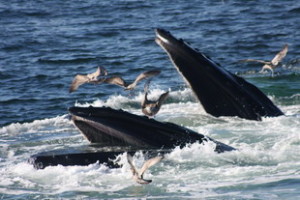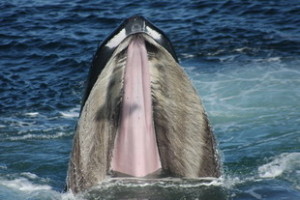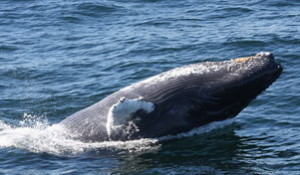Dolphin Fleet Naturalist Notebook 4 October to 10 October
On October 4th, strong, humid winds from the southwest made whale watching a bit of a challenge; however, we were able to find a mother and calf humpback pair in the southeastern sector of the Stellwagen Bank National Sanctuary. The massive splash left behind as the calf breached led us straight to the area, and we spent much of our time watching this young animal breach and lobtail, making quite a ruckus as its mothers went on deep dives, probably looking for food.
As humpback whale calves reach the end of their first year, they prepare to leave their mothers, who may very well become pregnant again this winter in their Carribean mating grounds. The calves may separate from their mothers as early as late autumn, or they may accompany mom back down to the lower latitude breeding areas.
By October 5th, winds had died down and we had a smoother ride out to the “Triangle” area, east of Stellwagen Bank. There, we found Canopy and her calf, along with a third humpback named Underline. This was surprising to those of us who had been watching Canopy and her calf nearly every day for the past few weeks. Since September, Canopy and her calf have been in the company of Whisk and her calf, Pele, and a rotating entourage of several other individuals. However, considering the ephemeral nature of humpback whale social association, these social rearrangements are to be expected.
As humpback whales mature, they are more likely to travel in small, although still short-term groups. With this knowledge, we were not surprised to find a pair of two mature female humpbacks, Glo and Anchor. Both Glo and Anchor were mothers in 2007. As there is no way of visually assessing whether or not a humpback is pregnant, we don’t know if these whales will return next season with calves, but considering the average calving interval to humpbacks is 2-3 years, we wouldn’t be surprised!
By October 6th, Canopy and her calf were back with their regular cohorts, Pele, Whisk, and Whisk’s calf. While the three adults went on deep dives, Whisk’s calf became curious about the presence of the Dolphin VIII and rolled around under the bow. Meanwhile, Canopy’s calf dramatically caught our attention in a different way by throwing itself out of the water with a huge breach!
Not to be outdone, Wavelength, another humpback in the area, began to lobtail. Although Wavelength was not associated with the group of six, perhaps the lobtailing was a way of acoustically communicating with the group in some way.
On October 7th, the same group of humpbacks was joined by a small pod of Atlantic white-sided dolphins. Odontocetes, or toothed whales, are less common visitors to the southern half of Stellwagen Bank, and as they leapt and surfed the waves around Whisk’s calf, the calf responded by swishing its tail, rolling, and gently slapping its flipper. The presence of the dolphins also highlighted the colossal size of the calf. A full grown Atlantic white-sided dolphin is no more than 9 feet long, while the calf, less than a year old, is nearly twice as long!
Later, as we returned on our afternoon trip, Whisk and her calf had split from the group, but Milkweed, Canopy, and Pele became very active at the surface, spyhopping, rolling, and seemingly socializing…perhaps a precursor to mating events that might take place in the Caribbean this winter!
On October 8th, another old favorite from our humpback population entered the scene. Apostrophe and her calf appeared at the periphery of the Whisk, Canopy, and Pele group. Like Whisk, Apostrophe was born in 1985. This year, she is accompanied by her seventh calf. Humpback whales reach reproductive maturity between the ages of five and ten. During the time that we have been observing and collecting data on this population, the average age of a humpback’s first calf seems to have increased. This is not an immediate cause for alarm, as humpback whale populations have been on the rise, but it is still a curious trend.
On October 9th, rather than heading east at Race Point light, we instead steamed north, towards the site of the old BE Buoy. The BE Buoy marks the shipping lane into Boston, but this shipping lane was recently shifted north in an effort to reduce shipstrikes of our whale populations, particularly the critically endangered North Atlantic right whale. Located in the center of Stellwagen Bank, the old BE Buoy often served as a visual landmark as the skyline of Provincetown was barely visible in the haze.
Our long trip north paid off! Over twenty different humpbacks were in the area, and they were all feeding! Abrasion, Rocker, Draco, and Ampersand were seen emerging through enormous bubble clouds with their  mouths wide open and full of fish. Humpback whales are known as “gulp feeders” and will blow spiraling columns of bubbles around schools of small fish to trap and confuse them. Humpbacks have also been known to use noises, known as “Megap-clicks” to further disorient their prey. After corralling the fish, they will lunge through the school with their mouths wide open, engulfing hundreds of gallons of food and water as the pleats lining their ventral side expand. After draining the salt water from their mouths by squeezing it between their baleen plates, they will then swallow several hundred pounds of fish, and then start the process over again.
mouths wide open and full of fish. Humpback whales are known as “gulp feeders” and will blow spiraling columns of bubbles around schools of small fish to trap and confuse them. Humpbacks have also been known to use noises, known as “Megap-clicks” to further disorient their prey. After corralling the fish, they will lunge through the school with their mouths wide open, engulfing hundreds of gallons of food and water as the pleats lining their ventral side expand. After draining the salt water from their mouths by squeezing it between their baleen plates, they will then swallow several hundred pounds of fish, and then start the process over again.
On October 10th, we headed north again, hoping to find a comparable scene. After getting a brief, albeit close look at a Minke whale, we came across our regular group of five humpbacks: Canopy, Whisk, their calves, as well as Pele. The three adults fluked slowly and gracefully as the calves floated at the surface, seemingly at rest. While observing these calves, a splash on the horizon suddenly caught our eye. It was several miles to the north, but we decided to investigate.
Our trip paid off when we once again found ourselves in the midst of approximately 10 feeding humpbacks, this time just south of the shipping lane. We were so far north that we could just barely seen the Boston skyline to the west of us! Three humpbacks seemed to be feeding in tandem, collectively blowing a net of bubbles before emerging with a wide open mouth. One of them appeared to roll over through the bubble cloud after taking a big gulp of food. We could clearly see the hundreds of baleen plates  completely lining the humpback whales’ upper jaw as they gulped down pounds of sand lance.
completely lining the humpback whales’ upper jaw as they gulped down pounds of sand lance.
Meanwhile, Coral, a 20 year-old male known for his distinct kick-feeding behavior, was up to his old tricks. Coral used his powerful tail to create a wall of bubbles. He would then lunge through the school of fish he had just entrapped, swimming along at the surface with his mouth wide open to get rid of the remaining salt water.
When we returned in the late afternoon, the feeding had subsided. The patchy nature of the fish schools in the North Atlantic make it difficult to predict when humpback whales will feed, but we know that they are trying to bulk up as much as they can, storing energy for their long trip down to the breeding grounds in the coming winter months.







